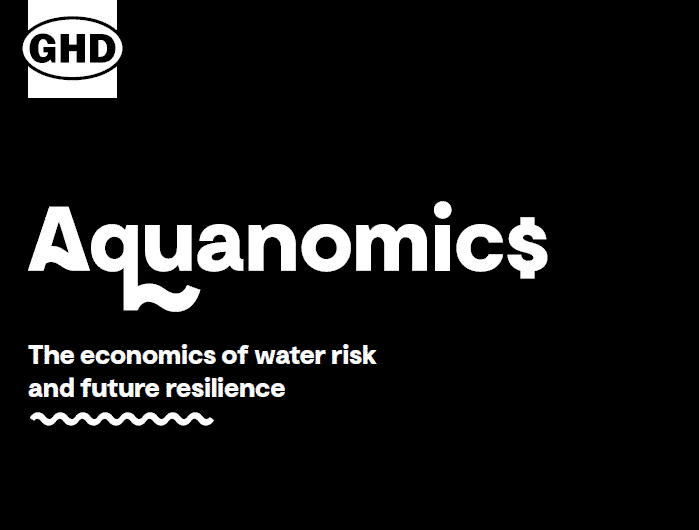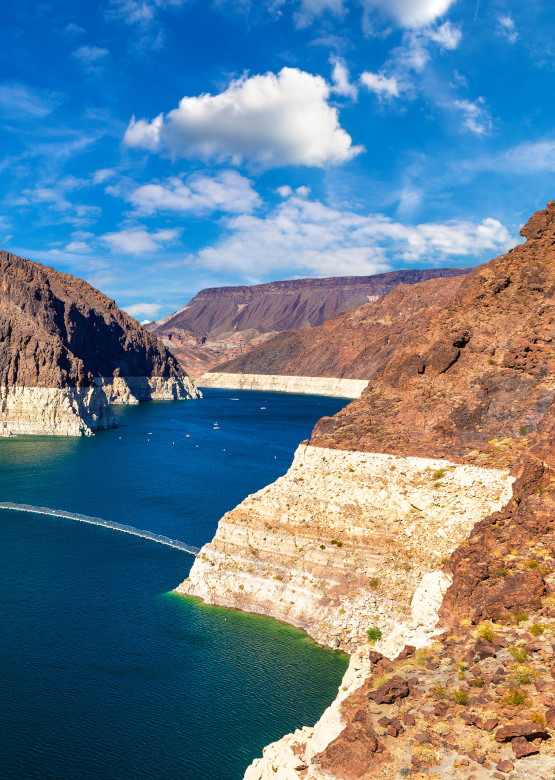



Aquanomics uses a bespoke model to estimate the future economic impact of water risk from droughts, floods and storms in 10 geographies at both a GDP and sector level. The numbers are staggering - $5.6 trillion could be lost between 2022 and 2050.
Communities across the world are already feeling the impact of increasing climatic events and it is crucial that we act now to protect them.
The water sector has the opportunity to lead change. More directed investment, focused innovation, and integrated water management is needed, and bringing communities along on this journey is key. Recognising the role of water as a connector between sectors – central to the development of a circular economy and a critical element of every business and supply chain – will also be part of the solution.
We need to reorient our relationship with water. It’s time to move away from viewing it as a commodity to be controlled, instead recognising its intrinsic value; water is part of a natural cycle, the balance of which must be restored and maintained if we are to live sustainably and prosperously.
Losses aren't just a problem for 2050. We will feel the impact in the next decade.

Data shows cumulative global GDP losses due to water risk from 2022 to 2050

Data showing direct losses by weather event type between 2022 - 2050


Loss varies by country or even region depending on a combination of factors including the state of an area’s existing infrastructure, local geographic and climate features, dominant industries, local prevention systems, existing government policies towards mitigation and more.
On the higher end, Australia, the Philippines and the US are projected to experience an average economic decline of between 0.5% and 0.7% in annual GDP in the years up to 2050. In other places such as the UAE and the UK – despite having very different economics and water risk exposure – it is estimated the average yearly impact to GDP will be just 0.1%.
Total GDP loss from 2022 to 2050:
Storms will cause the biggest economic impact
Agriculture sector stands to lose the most
Total GDP loss from 2022 to 2050:
Floods will cause the biggest economic impact
Banking & insurance sector stands to lose the most
Total GDP loss from 2022 to 2050:
Storms will cause the biggest economic impact
Agriculture sector stands to lose the most
Total GDP loss from 2022 to 2050:
Floods will cause the biggest economic impact
Manufacturing & Distribution and Energy & Utilities sectors stands to lose the most
Total GDP loss from 2022 to 2050:
Floods will cause the biggest economic impact
FMCG & retail sector stands to lose the most
Total GDP loss from 2022 to 2050:
Storms will cause the biggest economic impact
Agricultural sector stands to lose the most
Total GDP loss from 2022 to 2050:
Floods will cause the biggest economic impact
Manufacturing & distribution sector stands to lose the most
Data shown is total GDP loss between 2022 – 2050 in USD (billions) by country
Data shown is average annual GDP loss as a percentage between 2022 - 2050 by country
All businesses are dependent on water, no matter their size or sector. This makes water a connector between sectors, crucial to enabling circular economies and global supply chains. It also means that no sector is protected against operational disruption in the face of droughts, floods and storms.
Our Aquanomics model reveals the impact of water risk on five critical sectors within the global economy: agriculture; banking and insurance; energy and utilities; FMCG and retail; and manufacturing and distributions. While these sectors are diverse, with very different types and levels of water risk, they are all expected to face significant output losses in the years up to 2050, and this will have a significant impact on the millions of people who work across these areas.
Data shown is total global GDP loss in USD (billions) by sector between 2022 and 2050.
Agriculture is the world’s thirstiest industry – accounting for approximately 70% of global freshwater withdrawals. Our Aquanomics model estimates the sector could lose $332bn in economic output between 2022 and 2050.
Droughts have devastating effects on crop cultivation and livestock farming, while flooding and storms can damage infrastructure, crop lands, livestock shelter and farming equipment. Water-related disasters can also have a long-term impact on the productivity of agricultural land. Disruption to food production can impact imports and exports, which can affect global food security as well as impacting health and social equity within countries.
As a proportion of overall output, the banking and insurance sector has a more optimistic outlook compared to the other sectors. However, our Aquanomics model projects it could still incur losses of$514bn between 2022 and 2050.
These losses will primarily come from the indirect wider disruption caused by droughts, floods and storms, such as reductions in productivity and economic activity in the aftermath of these events. Additional long-term impacts include the disruption of trade, increased insurance payouts and the disruption of vital infrastructure.
The energy-water nexus means the availability of water resources can directly affect the productivity of energy systems, and vice-versa. Our Aquanomics model projects total output losses of $237bn to the energy and utilities sector by 2050.
Restricted access to water can limit energy production due to the shutdown of power plants (such as hydro and nuclear), while flooding and storms can result in direct damage to energy and water infrastructure, as well as limiting solar power production.
The FMCG and retail sector is heavily reliant on water infrastructure throughout its interconnected and complex supply chains. Our Aquanomics model predicts the sector could face total output losses of just over $1.1tn by 2050 due to water risk.
Water-related disasters can cause direct damage to infrastructure and assets, including buildings, inventory and machinery. It can also cause disruptions to supply chains through transport infrastructure such as roads and railways and compounding delays in global shipping caused by geopolitical uncertainties.
Our Aquanomics model predicts the manufacturing and distribution sector will be the most heavily affected by increasing water risk – facing total output losses of just over $4.2tn by 2050.
Manufacturing plays a fundamental role in the supply chains of all other sectors. Water scarcity can restrict industrial production processes, while flooding and storms can cause direct damage to assets (buildings, inventory and machinery) and energy supply. Water risk also impacts distribution; for example, extreme drought can cause disruption to waterborne transportation while flooding and storms can disrupt road and rail infrastructure.
Access to safe, affordable and reliable water is a fundamental human right and plays an increasingly crucial role in every part of the global economy, and yet it is one of our most undervalued resources. The water sector faces the twin issues of increasing requirements for water (both residential and commercial) and a potential reduction in supply due to climate change. The way in which the industry responds to these threats will be one of the most important challenges of the coming decades.


This study represents the first time the economic impact of water risk has been calculated at a GDP and sector level. It is part of our ongoing discussions with our clients and the wider industry about how we can collectively unlock more investment, greater innovation, and more integrated solutions globally.
The diversity of water risk that exists across the global means there is no one-size-fits-all solution for improving water resilience. Resilience in a region that is facing severe water scarcity can mean something very different when compared to a region where the greatest risk is posed by an over-abundance. It has also become clear that we can no longer rely solely on implementing costly, large-scale, engineered interventions.
So how can we tackle the challenge? Governments, businesses, communities and the water sector must adopt a long-term strategic view of resource management, focusing on three key principles:

Aquanomics: The economics of water risk and future resilience utilised a three-phased methodology to estimate the direct losses, sector losses and GDP losses that will be attributed to water risk (droughts, floods and storms) between 2022 and 2050. The study focuses on seven key countries across GHD’s footprint – Australia, Canada, China, the Philippines, the UAE, the UK and the US – and three US regions – Northeastern US, Southeastern US and Southwestern US. This study has focused predominantly on countries within the developed world to show that they – alongside the developing world - will be affected by water risk.
As global heating intensifies, extreme weather events are expected to increase, resulting in greater water risk to countries and regions. Unless otherwise stated, the figures in this study assume a 2-degree rise in global temperatures in line with the ‘absolute cap’ in global heating agreed by governments in the 2015 Paris Agreement.
Research design and concept development by GHD and Man Bites Dog. Economic modelling conducted by Cambridge Econometrics. Additional qualitative research into the environmental and social impact of water risk provided by Dr. Ania Grobicki, former Deputy Director of External Affairs at the Green Climate Fund and Executive Secretary of the Global Water Partnership.
Global insurance data was used to project the potential direct losses attributed to water risk (droughts, floods and storms) across the 11 geographies. This data is derived from Ortec Finance’s climate PREDICT model¹ which itself comprises several databases including the UN World Urbanization Program, NASA's Socioeconomic Data and Applications Center (SEDAC), National Centers for Environmental Information’s NOAA climate data, and Munich Re disaster/loss data. This is reported as the total direct losses between the years 2022-2050 and in currency terms (USD) by water risk type for each region.
We conducted a review of relevant literature into the effects of drought, flooding and water-related storm damage on five economic sectors. This was based on a total review of 19 research papers which provided model inputs into the impact of water risk by sector. The findings from the literature review were adjusted to reflect the sectoral composition of the selected regions.
The water risk loss data from stages 1 and 2 (estimated direct sector losses) was inputted into the E3ME economic model² as ‘shocks’ on capacity to ascertain the total economic impact of water risk across the 10 focus geographies.
These impacts include:
The outputs of the model are then reported in currency terms (total GDP USD losses between 2022 and 2050), a percentage of annual GDP and output at a sector level.
[1] Ortec Finance Climate PREDICT model quantifies the increase in frequency as well as impact (direct financial losses) of extreme weather risk per type of event (i.e. droughts, storms, floods) per different climate scenarios. Find out more: https://www.ortecfinance.com/en/insights/product/climate-predict
[2] The E3ME model is a dynamic computer-based macroeconomic model of the world’s economic and energy systems and the environment. Find out more: www.e3me.com